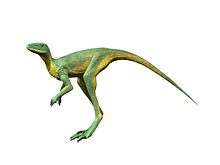Dinosauriformes
Dinosauriformes is a clade of archosaurian reptiles that include the dinosaurs and their most immediate relatives. All dinosauriformes are distinguished by several features, such as shortened forelimbs and a partially to fully perforated acetabulum, the hole in the hip socket traditionally used to define dinosaurs. The oldest known member is Asilisaurus, dating to about 245 million years ago in the Anisian age of the middle Triassic period.[2]
| Dinosauriformes | |
|---|---|
| Mounted skeleton of Marasuchus, an early dinosauriform which may be synonymous with Lagosuchus.[1] | |
| Scientific classification | |
| Kingdom: | Animalia |
| Phylum: | Chordata |
| Clade: | Dinosauromorpha |
| Clade: | Dinosauriformes Novas, 1992 |
| Subgroups | |
History
Dinosauriformes was coined in 1992 by F.E. Novas, who used it to include the herrerasaurs, which he did not consider members of Dinosauria proper. Contrary to Novas, most paleontologists since 1992 have considered herrerasaurs to be true dinosaurs, though many other primitive, dinosaur-like reptiles fall within his definition of Dinosauriformes. Dinosauriformes fall within the clade Dinosauromorpha.
Phylogeny
Cladogram simplified after Nesbitt et al. (2010) with the terminology of Cau (2018):[3]
| Dinosauriformes |
| ||||||||||||||||||||||||
References
- Agnolin, Federico L.; Ezcurra, Martin D. (2019). "THE VALIDITY OF LAGOSUCHUS TALAMPAYENSIS ROMER, 1971 (ARCHOSAURIA, DINOSAURIFORMES), FROM THE LATE TRIASSIC OF ARGENTINA" (PDF). Breviora. 565 (1): 1–21. doi:10.3099/0006-9698-565.1.1. ISSN 0006-9698.
- Nesbitt, S.J.; Sidor, C.A.; Irmis, R.B.; Angielczyk, K.D.; Smith, R.M.H.; Tsuji, L.M.A. (2010). "Ecologically distinct dinosaurian sister group shows early diversification of Ornithodira". Nature. 464 (7285): 95–98. doi:10.1038/nature08718. PMID 20203608.
- Andrea Cau (2018). "The assembly of the avian body plan: a 160-million-year long process" (PDF). Bollettino della Società Paleontologica Italiana. 57 (1): 1–25. doi:10.4435/BSPI.2018.01.
Sources
- Ezcurra, M.D. (2006). "A review of the systematic position of the dinosauriform archosaur Eucoelophysis baldwini Sullivan & Lucas, 1999 from the Upper Triassic of New Mexico", USA. Geodiversitas, 28 (4): 649-684.
- Hutchinson, J.R. & Gatesy, S.M. (2000). "Adductors, abductors, and the evolution of archosaur locomotion". Paleobiology 26 (4): 734-751
- Novas, F.E. (1996). "Dinosaur Monophyly". Journal of Vertebrate Paleontology 16 (4): 723-741.
- Sereno, P.C. and Arcucci, A.B. (1994). "Dinosaur precursors from the Middle Triassic of Argentina: Lagerpeton chanarensis". Journal of Vertebrate Paleontology 13: 385-399.









